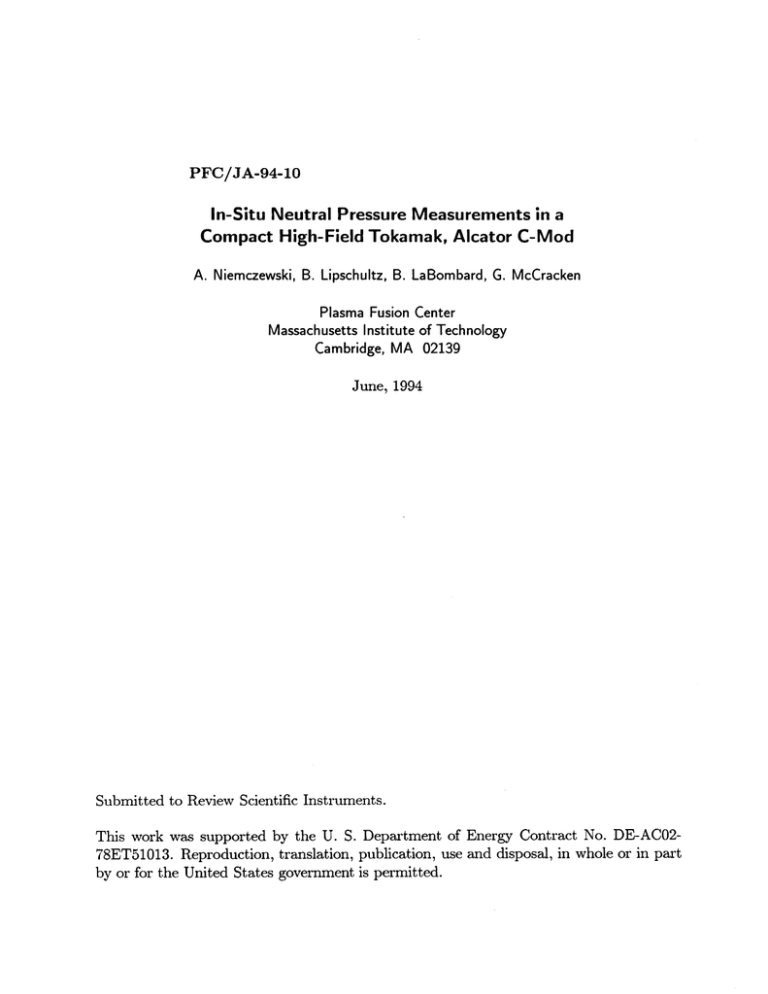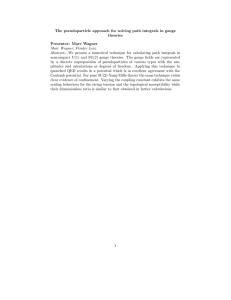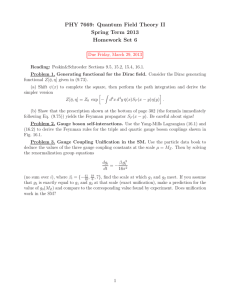In-Situ Neutral Pressure Measurements in a PFC/JA-94-10 78ET51013.
advertisement

PFC/JA-94-10 In-Situ Neutral Pressure Measurements in a Compact High-Field Tokamak, Alcator C-Mod A. Niemczewski, B. Lipschultz, B. LaBombard, G. McCracken Plasma Fusion Center Massachusetts Institute of Technology Cambridge, MA 02139 June, 1994 Submitted to Review Scientific Instruments. This work was supported by the U. S. Department of Energy Contract No. DE-AC0278ET51013. Reproduction, translation, publication, use and disposal, in whole or in part by or for the United States government is permitted. In-Situ Neutral Pressure Measurements in a Compact High-Field Tokamak, Alcator C-Mod* A. Niemczewski, B. Lipschultz, B. LaBombard, G. McCracken Plasma Fusion Center, MIT, Cambridge,MA 02139, USA ABSTRACT The Alcator C-Mod advanced divertor program requires fast, in-situ, absolutely calibrated neutral pressure measurements. The concept of a linear-geometry ionization gauge, first implemented at Princeton and Garching, was further developed at the MIT Plasma Fusion Center, to meet Alcator C-Mod requirements. Although gauges of similar design are being used on other tokamaks, nowhere else is the gauge subjected to such high magnetic fields as in Alcator (4.3T during the 1993 campaign,). Additionally, the compact design of Alcator imposes constraints on the location and mechanical design of the gauge. In order to interpret correctly experimental data, the gauge was subjected to a series of in-situ calibration tests. It has been found that the gauge sensitivity increases with increasing parallel (to gauge axis) magnetic field. In the high-pressure, high-field limit the basic assumption of the operation of ionization gauges, Ii/Ie<<l, no longer holds. However, when a different expression for sensitivity is used, the gauge response is linear over a broad pressure range. This sensitivity, is a strong function of the electron current. The MIT gauge was used during the 1993 operational campaign. A pressure build-up in the divertor was observed during diverted plasma discharges. * Supported by U.S. DOE Contract No. DE-AC02-78ET51013. Neutral Pressure in C-Mod, . 1. Niemczewski et al., I. NEUTRAL PRESSURE MEASUREMENTS IN MAGNETIC FUSION DEVICES. Techniques for neutral pressure measurements in magnetic fusion devices (reviewed by Dylla 1 ) have been investigated since the early days of the fusion program. Among others, a hot-filament ionization gauge is of interest for in-situ , fast time response operation. However, as initially pointed out by Martin 2 , the response of such a gauge depends on its geometry and orientation relative to the magnetic field. Various gauge geometries, including cylindrical 3 and spherical 4 , have been proposed for use in magnetic fields. For Alcator C-Mod a linear-geometry hot-filament ionization gauge was chosen as the most suitable for very high magnetic fields (ultimately 9T). A linear-geometry ionization gauge of the Shultz-Phelps type was first used in fusion experiments by Lewin and Martin 5 in Princeton stellerators. More recently, a similar-principle gauge, but with a different electrode arrangement, was developed by Haas and first used in the Asdex tokamak 6 . The Asdex-type gauge 7 , as it will be referred to herein, is commercially available and is being used at a number of other tokamaks (e.g., JET, DIII-D, ToreSupra). II. MIT IONIZATION GAUGE DESIGN. The in-situ ionization gauge developed at MIT employs the same operational principle as the Lewin-Martin and Asdex gauges, i.e. electron emission modulation to discriminate against background noise. It has the same geometry as the Asdex gauge but with different support structure and ceramic-coated body (FIG. 1). Additionally, the electronic circuitry employs a synchronous demodulation technique rather than a sample-and-hold method used in the Asdex gauge. The choice of bias voltages (FIG. 1) was based on earlier designs mentioned above and on tests performed in weak magnetic fields. The bias voltages chosen for the MIT gauge are near the maximum ionization efficiency and have not been varied during the in-situ calibration described below. III. MIT GAUGE CALIBRATION. Since absolute pressure measurements are essential for the Alcator C-Mod divertor physics program, a series of extensive in-situ calibration experiments has been performed. The MIT gauge was calibrated against a Bayard-Alpert type ionization gauge installed on an extension pipe (~12ms time-response in D2) at the midplane of the tokamak and shielded from magnetic fields. The B-A gauge had in turn been earlier calibrated against capacitance manometers (using direct-comparison and expansion-from-small-volume Neutral Pressure in C-Mod, . 2. Niemczewski et al., methods). All of the calibration experiments were performed in deuterium, however the sensitivity numbers presented below are expressed using nitrogen-equivalent pressures. The MIT gauge was used in two primary modes of operation: (1) The active feedback mode, which maintains the total electron current constant by adjusting the filament heating current. The feedback loop time constant is dominated by the heating time (50300ms) of the filament and its support. (2) The constant filament heating voltage mode, which maintains the primary electron emission approximately constant, drifting slowly (typically a few percent per second). The following parameters were identified as most influential on the gauge sensitivity, and were varied within the ranges indicated: A. - parallel magnetic field (B toroidal in Alcator) 0-4.3T (at the gauge location), B. - pressure 0.03 - 7 mTorr of deuterium, C. - electron current 3-60RA as measured on the electron collector, D. - perpendicular field (primarily vertical component: B z in Alcator) 0-0.6T (at the gauge location) In order to quantify the influence of the above parameters a series of experiments was performed, in which only one parameter was varied at a time. A. GAUGE RESPONSE TO PARALLEL MAGNETIC FIELD The gauge sensitivity increases monotonically with applied toroidal magnetic field (parallel to gauge axis and direction of the electric field). FIG. 2. shows enhancement of the gauge sensitivity (expressed in the form discussed below), normalized to unity at Btor=O. The sensitivity rises quickly (factor of 5) up to 0.5T, and then exhibits a much slower rise (adding a factor of 1.5 per 1T). There are no signs of saturation in the range examined (0-4.3T). A possible explanation of the sensitivity enhancement is increasing confinement of electrons along magnetic field lines with increasing parallel field. This in turn would extend electron life-time in the resulting magneto-electrostatic trap and lead to a larger number of ionizations per collected electron. An observation in support of this hypothesis is that at a field above 0.01T (which corresponds to the electron Larmor radius < grid spacing) the collected electron current drops dramatically, e.g., from 300gA to 30pA (with constant filament heating voltage), most likely due to emission limitation by the space charge of trapped electrons. Neutral Pressure in C-Mod, - 3. Niemnczewski et al., B. PRESSURE LINEARITY Schultz and Phelps 8 listed the necessary conditions for the linear response of their high pressure ionization gauge. One of the most important conditions is that Iion/lelectron<<l. In a later work, Martin and Lewin 9 reported a decrease of their gauge sensitivity with increasing pressure. From the graph published there, a ratio Ii/Ie=0.I can be deduced, violating the Shultz-Phelps prescription. Similarly the Asdex gauge was also found to have a changing sensitivity in the high pressure range, with Ii/Ie=0.5, as reported by Klepper 10. A similar problem is encountered on Alcator C-Mod, when the ratio Ii/le reaches 0.3, due to very high magnetic fields and high pressure operation (mTorr range). The two quantities measured in the gauge are the ion collector current, Ii and the electron collector current le. The latter can be expressed as: Ie =Iep + Ies (1) Where Iep is the primary electron current consisting of the filament emission (Iefil), less the modulator collection (Iemod): (2) Iep = Iefil - Iemod Ies is the electron current resulting from the volumetric ionization and secondary electrons from the ion collector. The number of electrons produced by ionization should be proportional to the ion current. We can therefore define a gauge sensitivity S by the equation: (3) Ii/(le - a Ii)= S p During a series of experiments in a constant parallel field Ii and Ie were measured as a function of pressure, p. The sensitivity defined by equation (3) was found to be a linear (within 20%) function of pressure over the range of 0.03 - 7 mTorr deuterium and a was found empirically to be 2.1. For simplicity a = 2 was assumed for remaining calculations. C. SENSITIVITY DEPENDENCE ON ELECTRON CURRENT Similar to the Lewin-Martin gauge, the MIT gauge sensitivity was found to depend on electron current. The sensitivity defined above was found to be a strongly decreasing function of the primary electron current (but not the collected electron current le), when Iep is expressed as: (4) lep = le - (X Ii This dependence (shown on FIG. 3), is different for different modes of operation of the gauge (e.g. feedback vs. constant voltage control and presence of a perpendicular magnetic field). The conclusion drawn from above experiments is that it is desirable to operate the gauge at higher electron current (30-60 iA), i.e. at points where the sensitivity does not Neutral Pressure in C-Mod, .4.- Niemczewski et al., vary significantly. Also such operation lowers the danger of developing a self-sustained discharge inside the gauge and improves signal-to-noise ratio for Ie measurement. Another conclusion is that the most desirable mode of operation would be an active feedback control of the primary electron current Iep, maintaining constant gauge sensitivity. This is, however, very difficult in practice. An active feedback control of the collected electron current Ie, does not provide constant sensitivity with pressure (due to changing Ii). It is, however, preferred to the constant heating voltage operation because of better predictability of one of the measured quantities (le). D. RESPONSE TO PERPENDICULAR MAGNETIC FIELD The MIT gauge is designed in such a way that a 15 degree angle between magnetic field direction and gauge axis in any direction should still allow for 100% collection of both ions and electrons. None of the users of the Asdex gauge have reported any change in sensitivity due to perpendicular fields within a similar 15 degree angle limit 1 1 ,12 . The MIT gauge sensitivity (bottom part of FIG. 3) is reduced by the presence of a steady state perpendicular field (B z in Alcator) added to the parallel field, even though the 15 degree angle limit is not exceeded. During some experiments transient changes in gauge behavior were observed. These transients were associated with large dBz/dt rather than with Bz or Br itself. A dBz/dt value exceeding 0.5T/s causes the electron current to drop abruptly and ion current to abruptly rise, changing the gauge sensitivity. Both phenomena, B z and dBz/dt dependance, may be associated with shortening electron life-time in the magnetoelectrostatic trap, but have not been investigated further. During the steady state portion of the plasma discharge dB z/dt does not exceed 0.5T/s. In this phase of the pulse the gauge is insensitive to the small changes in the perpendicular fields and provides a reliable pressure measurement. During the plasma current ramp or termination the gauge output has to be used with caution. IV. MEASUREMENTS DURING DIVERTED PLASMA DISCHARGES During the 1993 tokamak operation data were obtained from the gauge located behind a divertor module with high gas conductance to the tokamak main chamber. Since such an 'open' module does not trap neutrals well, the only divertor pressure build-up (compared to the midplane pressure) would result from the 'plugging' of the 'open' module by plasma itself. A moderate pressure build-up (0.8 -1.4 mTorr compared to 0.1 -0.2 mTorr at the midplane) was observed during diverted plasma discharges (FIG. 4). The divertor Neutral Pressure in C-Mod, - 5- Niemcezewski et al., pressure decays slowly, with some time delay, after the gas puffing has been turned down. This is in contrast to a constant, or slightly rising, value of the midplane pressure. V. CONCLUSIONS In-situ pressure measurements in the Alcator C-Mod tokamak are performed using a hot filament linear-geometry ionization gauge developed at MIT, following the principle implemented in the Asdex gauge. The gauge sensitivity is enhanced by about a factor of 11 by the parallel magnetic field of 4.3T. This enhancement combined with a mTorr pressure-range causes the basic assumption of ionization gauge measurements, Ii/Ie<<1, to become invalid. Additional sources of electrons become important in this high-field, high-pressure limit. A new expression for gauge sensitivity, taking the above effect into account, allows one to use gauge output as a linear function of pressure for broad range of pressures. The sensitivity of the gauge, is, however, a function of primary electron current and gauge mode of operation. Extensive calibration experiments, described above, have increased our confidence in that the MIT ionization gauge delivers reliable, absolutely calibrated, pressure measurements, necessary for the Alcator C-Mod divertor physics program. 1 H. F. Dylla, J. Vac. Sci. Technol. 20(2), 119 (1982). 2 G. D. Martin, Jr., in 1961 Transactionsof the 8th Vacuum Symposium and 2nd InternationalCongress of the American Vacuum Society (Pergamon, New York, 1962), p. 476. L. Stansfield, B. Bergevin, J. M. Larsen, J. Vac. Sci. Technol. A 4(5), 2284 (1986). 4 N. Ogiwara, and M. Maeno, J. Vac. Sci. Technol. A 6(5), 2870 (1988). 5 G. Lewin and G. Martin, PPL Report MATT-203 (1963). 6 G. Haas et al, J. Nucl. Mater. 121, p. 151 (1984). 3 B. 7 G. 8 G. Haas, US Patent No. 4792763. J. Shultz and A. V. Phelps, Rev. Sci. Instrum. 28, 1051 (1957). 9 G. Lewin and G. Martin, Rev. Sci. Instrum. 33,447 (1962). 10 C. C. Klepper, T. E. Evans, G. Haas, G. L. Jackson, R. Maingi, J. Vac. Sci. Technol. A 11(2), 446 (1993). 1 1 C. C. Klepper, private communication, October 1993. 12 G. Haas, private communication, Feb. 1994. Neutral Pressure in C-Mod, - 6. Niemczewski et al., In-Situ Neutral Pressure Measurements in a Compact High-Field Tokamak, Alcator C-Mod A. Niemczewski, B. Lipschultz, B. LaBombard, G. McCracken Plasma Fusion Center, MIT, Cambridge, MA 02139, USA LIST OF FIGURE CAPTIONS: FIG. 1. Top view of the partially assembled MIT gauge showing the geometry and applied bias voltages. FIG. 2. Gauge sensitivity to the parallel magnetic field, normalized to unity at Btor=O. Traces for field ramp-up and ramp-down are overlaid. At Btor=0.5T the slope of the curve changes. FIG. 3. Gauge sensitivity, defined as S=Ii/((Ie-2Ii)p), plotted versus primary electron current lep = Ie - 21i for different modes of gauge operation. The sensitivity defined above is a function of the primary electron current, but differs for different operation regimes. FIG. 4. Diverted plasma discharge. A moderate pressure build-up in the open divertor module occurs between t = 0.1 - 0.6 s of the discharge. Divertor pressure decays slowly (in contrast with the midplane pressure) after the gas puffing rate has been turned down. Neutral Pressure in C-Mod - 7 - Niemnczewski et al. CeramicCoated Body 4- - 11.7 mm 3.3 mm 1.3 mm 0 K I E ]I ]D Heating Current Buses 0 Bz# 0 Btor N1.1 ION COLLECTOR (solid plate, 0 ELECTRON COLLECTOR (vertical grid, area =514 mmA2) 0.1 mm bars, E=OV 0.4 mm spacing) E = +250 V FILAMENT (thoriated tungsten 0 0.76 mm) E=+70V MODULATOR (vertical grid, 0.1 mm bars, 0.4 mm spacing) E = +20/+120V A. Niemczewski, Fig. 1 -8- Cd Cd CCC -------- .. . . . . m 00 t-in It . .. .. . . . . . .. - -- -. c cq -I C k 0 ca z z PR PR 0 0 ................... ....................................... ..................................................................... .................. ........................ ................... ................... ........................ El .................. ............................ ................. E3 ................... -Ana I z 1:1 .............. .............................. ................ ............................. ............................ ...................... ......................... ................... .................... < .......... ............................ ....................................... ................ ......................................... ....... I ....................................... .............. .- T ........................... ................. ....... .................. ...................................... ................................. ...... ............... ..................... ......... .............. ....... ............................................................................... ....................................... . ..................... ................................. ........................... ...................................... [jjLtu/T] (d(!IZ-al))/Il = S - 10 - :,SjjAIjjSUaS ;Anul) Diverted Plasma Discharge, Shot 931025030 Plasma -CurreA I-i- [MAI ... -------------------.......................... ............ ...... U 6 -------------- ---------..... .... .........................------------......... ...........-----------------0.-66 .................. -----------------.0 A -----------------.. ................................................................ 0.2 .2 .1.5 0 .5 ------- 64 0'6 0:8 -0 ne Avg. Electron Density <ne> [1e20/m31 ---------------------------------------------------------...... ------------ 02 OA -0.6' --0:8 .. ............................................................ ...............D21 .------------------Divertor 0 ; 8 ---------------------------------Neutral ---------------Pressure --------.. [mTr . ...... ........................... -------.... ............. . . . . . . .. . . . . .0 .-6 ------- ----------------------.........---------------------------------------------OA ......... ......................... -------------------------- ---------------------------------------0.-2 ----------------- -..............-------------------------------------------------------------------------0 :8 Oi 6 OA 0 :2 0 Midplane Neutral Pressure [mTr D21 0.8 ------------------------------------------------ -------------------------0 .-6 ---------........ ..........---------------------------........ ---------...................... .......... OA -------- --0.-2 ----------- ......................... ----------------------*.......... ........... --- ............ ................... -----------------------------------O8 0:6 O:A 0:2 0 Main Valve Flow [le20:moleculesD2/sl ------------------------------------------------------.1 0-------------------..... ....... 5 ------------ ...................-------------------...................-------------------.......... .0:2 0.4 0 :6 OS .. ....






